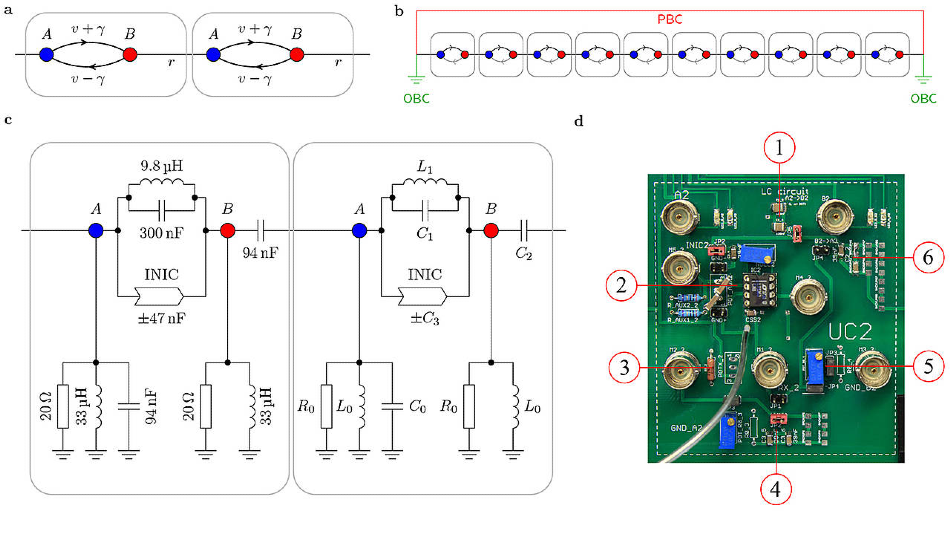Jun 11 2020
Topological metamaterials are used as an innovative means to investigate and analyze unique effects. Rather than using natural materials, scientists perform an artificial arrangement of the constituents of a topological metamaterial into a regular structure.
 On the right, a unit cell cutout of the circuit board, which was built to demonstrate the non-Hermitian skin effect, is shown. In (a), the underlying theoretical non-Hermitian model is sketched, which describes the couplings between adjacent nodes; (b) depicts a schematic diagram of the full circuit chain with 20 unit cells with either periodic (without boundary) or open boundary conditions. (c) Circuit schematic of the periodically repeated unit cell with two internal nodes. Image Credit: Lehrstuhl für Theoretische Physik I/Universität Würzburg.
On the right, a unit cell cutout of the circuit board, which was built to demonstrate the non-Hermitian skin effect, is shown. In (a), the underlying theoretical non-Hermitian model is sketched, which describes the couplings between adjacent nodes; (b) depicts a schematic diagram of the full circuit chain with 20 unit cells with either periodic (without boundary) or open boundary conditions. (c) Circuit schematic of the periodically repeated unit cell with two internal nodes. Image Credit: Lehrstuhl für Theoretische Physik I/Universität Würzburg.
This arrangement is similar to a solid state where a crystal lattice is formed by the atoms. These platforms are typically used to mimic specific properties of solids to render them flexible for experimental analysis.
At Julius-Maximilians-Universität (JMU) Würzburg in Bavaria, Germany, physicists carry out studies on such topological metamaterials, a central framework of the Würzburg-Dresden Cluster of Excellence ct.qmat—Complexity and Topology in Quantum Matter.
Novel Topological Phenomena
An associated them of solid-state research in Würzburg is to find and characterize innovative topological phenomena. This is related to the analysis of topological insulators, which act as insulators in the bulk, but include conducting surface states.
Researchers across the globe take part in intensive studies on these materials as they feature powerful physical phenomena. This line of research could someday result in advances in semiconductor technology or even in other fields.
The JMU researchers have described the results of their new study in the Nature Physics journal. In general, topological insulators are regarded as isolated (Hermitian) systems. On the contrary, topological metamaterials can be tweaked to analyze the implications of the exchange of energy with the environment.
Such interactions have an impact on the system’s behavior from outside, as it would be in the case of friction. The researchers experimentally verified the non-Hermitian skin effect (NHSE) predicted earlier in theory.
All States Localize at the Edge
In the NHSE, contrary to a usually topological insulator, not just a small fraction but all states of the material occur at its edge. In other words, they are localized there. This phenomenon has been explained by Tobias Helbig and Tobias Hofmann, the joint first authors of the study. Both of them are PhD students in the research group of Professor Ronny Thomale, head of the JMU Chair of Theoretical Physics I.
Our research shows, among other things, that the physical principles known from isolated solid state systems need to be fundamentally modified in the non-Hermitian case.
Tobias Helbig and Tobias Hofmann, Joint First Authors, Universität Würzburg
It would take a longer time for the results of the new study to find a direct application. However, they exhibit the potential to enhance highly sensitive optical detectors, for instance.
Electric Circuits as a Center of Innovation in Basic Research
The experiments that led to the new outcomes were performed in collaboration with the group of Dr Tobias Kießling and the JMU Chair of Experimental Physics III. Professor Alexander Szameit from the University of Rostock offered additional contributions and concepts. JMU Physicists worked jointly with Szameit’s group on the area of topological photonics within the cluster of excellence ct.qmat.
The JMU researchers experimentally demonstrated the non-Hermitian skin effect by using electric circuits with periodically arranged elements. Since they resemble the crystal structure of a solid, artificially arranged experimental settings such as those are classified as a metamaterial.
Applications of Topological Matter in Sight
The researchers intend to further explore the interplay between non-Hermitian physics and topological states. One major question will be to the extent to which the topological protection of states stays unaffected when there are interactions with the environment.
In the long run, the researchers wish to advance toward quantum hybrid circuits where they intend to integrate superconducting or other quantum mechanical circuit elements. Circuits such as those prove to be a flexible platform for the discovery of innovative phenomena.
We aim to transfer the insights from topological circuits to other metamaterial platforms in the pursuit of potential applications.
Ronny Thomale, Professor and Head, Chair of Theoretical Physics I, Universität Würzburg
This includes optical configurations like photonic waveguides. In such configurations, topologically protected states in non-Hermitian systems could be useful to improve signal processing and detectors, and even to develop a photonic quantum computer. Finally, the main aim of the studies on topological metamaterials is the reconnection of innovative effects to actual solid states.
The study was funded by the German Research Foundation (DFG) in the Collaborative Research Center SFB-1170 Tocotronics and within the Cluster of Excellence ct.qmat (Würzburg-Dresden).
Journal Reference:
Helbig, T., et al. (2020) Generalized bulk-boundary correspondence in non-Hermitian topolectrical circuits. Nature Physics. doi.org/10.1038/s41567-020-0922-9.